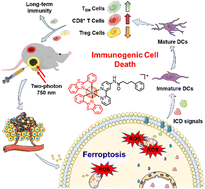Professor Yi-Tao Long’s Editor’s Choice
We are delighted to share with you our latest Editor’s Choice collection that presents a selection of notable research contributions in analytical chemistry and sensors in Chemical Science from 2023 to 2024.
The featured articles selected by Chemical Science Associate Editor, Yi-Tao, demonstrate 18 cutting-edge papers in analytical chemistry and sensors, highlighting innovations in imaging, diagnostics, phototherapy, mass spectroscopy, AI-powered detection and more.
From photodynamic therapy to high-throughput proteomics, these studies showcase key advances in analytical chemistry and the creativity and interdisciplinary strength of chemical research published in Chemical Science.
Professor Long considers work at the forefront of analytical chemistry, including significant advances in spectroscopic analysis and electrochemistry. Submit your best manuscripts on these topics to Chemical Science for Professor Long’s consideration.
We hope you enjoy reading this selection of articles chosen by Professor Yi-Tao Long.
| A mitochondria-localized iridium(III) photosensitizer for two-photon photodynamic immunotherapy against melanoma
Lili Wang, Johannes Karges, Fangmian Wei, Lina Xie, Zhuoli Chen, Gilles Gasser, Liangnian Ji and Hui Chao Chem. Sci., 2023, 14, 1461-1471 |
 |
 |
|
|
Chem. Sci., 2023, 14, 4308-4318 |
 |
|
Chem. Sci., 2023, 14, 2901-2909 |
 |
|
Chem. Sci., 2023, 14, 2318-2324 |
 |
|
The compact integration of a cascaded HCR circuit for highly reliable cancer cell discrimination Chem. Sci., 2023, 14, 2159-2167 |
 |
|
Automatic materials characterization from infrared spectra using convolutional neural networks Chem. Sci., 2023, 14, 3600-3609 |
 |
|
Chem. Sci., 2023, 14, 4863-4871 |
 |
|
All-in-One digital microfluidics pipeline for proteomic sample preparation and analysis Chem. Sci., 2023, 14, 2887-2900 |
 |
|
Chem. Sci., 2024, 15, 757-764 |
 |
|
Chem. Sci., 2024, 15, 6488-6499 |
 |
|
Redox-mediated electrochemiluminescence enhancement for bead-based immunoassay Chem. Sci., 2024, 15, 1150-1158 |
 |
|
Chem. Sci., 2024, 15, 3633-3639 |
 |
|
Chem. Sci., 2024, 15, 3255-3261 |
 |
|
Chem. Sci., 2024, 15, 6314-6320 |
![Graphical abstract: High-throughput single-cell mass spectrometry enables metabolic network analysis by resolving phospholipid C [[double bond, length as m-dash]] C isomers](https://pubs.rsc.org/en/Image/Get?imageInfo.ImageType=GA&imageInfo.ImageIdentifier.ManuscriptID=D3SC06573A&imageInfo.ImageIdentifier.Year=2024) |
|
High-throughput drug target discovery using a fully automated proteomics sample preparation platform Chem. Sci., 2024, 15, 2833-2847
|
 |
|
Chem. Sci., 2024, 15, 18419-18430 |
 |
|
Chem. Sci., 2024, 15, 10092-10100 |
 |
If you are interested in research in similar areas, explore our most popular 2024 analytical chemistry articles collection and our related Imaging, biosensing and diagnostics: 2025 Chemical Science symposium collection.
Chemical Science is the flagship journal of the Royal Society of Chemistry, publishing exceptional research across the chemical sciences. As a diamond open access journal, all of our articles are free to read and free to publish – find out more and browse our latest articles on our webpage.
Keep up to date with our latest articles, reviews, collections & more by following us on Bluesky, LinkedIn or by signing up to our E-Alerts.



![[double bond, length as m-dash]](https://www.rsc.org/images/entities/char_e001.gif) C isomers
C isomers







